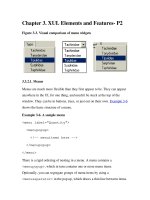chapter 3 intrusive igneous rocks
Bạn đang xem bản rút gọn của tài liệu. Xem và tải ngay bản đầy đủ của tài liệu tại đây (2.87 MB, 39 trang )
Igneous Rocks, Intrusive
Activity, and the Origin of
Igneous Rocks
Physical Geology 13/e, Chapter 3
Tim Horner, CSUS Geology Department
The Rock Cycle
• A rock is a naturally formed,
consolidated material usually
composed of grains of one or
more minerals
• The rock cycle shows how one
type of rocky material gets
transformed into another
– Representation of how rocks are
formed, broken down, and processed
in response to changing conditions
– Processes may involve interactions
of geosphere with hydrosphere,
atmosphere and/or biosphere
– Arrows indicate possible process
paths within the cycle
The Rock Cycle and Plate
Tectonics
• Magma is created by melting of rock
above a subduction zone
• Less dense magma rises and cools
to form igneous rock
• Igneous rock exposed at surface
gets weathered into sediment
Convergent plate boundary
• Sediments transported to low areas,
buried and hardened into sedimentary rock
• Sedimentary rock heated and squeezed at depth to form
metamorphic rock
• Metamorphic rock may heat up and melt at depth to form magma
Igneous Rocks
• Magma is molten rock
• Igneous rocks form when magma
cools and solidifies
– Intrusive igneous rocks form when
magma solidifies underground
Granite
• Granite is a common example
– Extrusive igneous rocks form when
magma solidifies at the Earth’s
surface (lava)
• Basalt is a common example
Basalt
Igneous Rock Textures
• Texture refers to the size, shape and
arrangement of grains or other constituents
within a rock
• Texture of igneous rocks is primarily
controlled by cooling rate
• Extrusive igneous rocks cool quickly at or
near Earth’s surface and are typically finegrained (most crystals <1 mm)
• Intrusive igneous rocks cool slowly deep
beneath Earth’s surface and are typically
coarse-grained (most crystals >1 mm)
Fine-grained igneous rock
Coarse-grained igneous rock
Special Igneous Textures
• A pegmatite is an extremely coarse-grained
igneous rock (most crystals >5 cm) formed
when magma cools very slowly at depth
• A glassy texture contains no crystals at all,
and is formed by extremely rapid cooling
• A porphyritic texture includes two distinct
crystal sizes, with the larger having formed
first during slow cooling underground and
the small forming during more rapid cooling
at the Earth’s surface
Pegmatitic igneous rock
Porphyritic igneous rock
Igneous Rock Identification
Igneous rock names are based on texture (grain size) and
mineralogic composition
Textural classification
•
•
–
–
Plutonic rocks (gabbro-diorite-granite) are coarse-grained and cooled
slowly at depth
V olcanic rocks (basalt-andesite-rhyolite) are typically fine-grained and
cooled rapidly at the Earth’s surface
Compositional classification
•
–
–
–
Mafic rocks (gabbro-basalt) contain abundant dark-colored
ferromagnesian minerals
Intermediate rocks (diorite-andesite) contain roughly equal amounts of
dark- and light-colored minerals
Felsic rocks (granite-rhyolite) contain abundant light-colored minerals
Igneous Rock Identification
•
Igneous rock names are based on texture (grain size) and
mineralogic composition
Chemistry (mineral content)
Igneous Rock Chemistry
Rock chemistry, particularly silica (SiO2) content, determines
mineral content and general color of igneous rocks
•
–
Mafic rocks have ~50% silica, by weight, and contain dark-colored
minerals that are abundant in iron, magnesium and calcium
•
–
Felsic (silicic) rocks have >65% silica, by weight, and contain lightcolored minerals that are abundant in silica, aluminum, sodium and
potassium
•
–
Intrusive/extrusive felsic rocks - granite/rhyolite
Intermediate rocks have silica contents between those of mafic and
felsic rocks
•
–
Intrusive/extrusive mafic rocks - gabbro/basalt
Intrusive/extrusive intermediate rocks - diorite/andesite
Ultramafic rocks have <45% silica, by weight, and are composed
almost entirely of dark-colored ferromagnesian minerals
•
Most common ultramafic rock is peridotite (intrusive)
Intrusive Rock Bodies
•
Intrusive rocks exist in bodies or structures that penetrate
or cut through pre-existing country rock
•
Intrusive bodies are given names based on their size,
shape and relationship to country rock
–
Shallow intrusions: Dikes and sills
•
•
•
Form <2 km beneath Earth’s surface
Chill and solidify fairly quickly in
cool country rock
Generally composed of
fine-grained rocks
Insert new Fig. 3.11 here
Intrusive Rock Bodies
•
Intrusive rocks exist in bodies or structures that penetrate
or cut through pre-existing country rock
•
Intrusive bodies are given names based on their size,
shape and relationship to country rock
–
Deep intrusions: Plutons
•
•
•
Form at considerable depth beneath
Earth’s surface when rising blobs of
magma (diapirs) get trapped within
the crust
Crystallize slowly in warm
country rock
Generally composed of
coarse-grained rocks
Intrusive Rock Bodies
V olcanic neck
•
–
Shallow intrusion formed when magma
solidifies in throat of volcano
Dike
•
–
Tabular intrusive structure that cuts across
any layering in country rock
Light-colored dikes
Sill
•
–
Tabular intrusive structure that parallels
layering in country rock
Pluton
•
–
–
Large, blob-shaped intrusive body formed
of coarse-grained igneous rock, commonly
granitic
Small plutons (exposed over <100 km 2) are
called stocks, large plutons (exposed over
>100 km2) are called batholiths
Basaltic sill
Sierra Nevada batholith
Deep intrusive structures:
Batholiths
• Surface exposure >
100 km2
What causes rocks to melt?
The internal Earth is hot.
Temperature increases downward
Yet the interior of the Earth is mostly solid
Melts occur by three processes:
Decompression melting
Heating
Water-flux melting
Decompression
melting:
LIQUID
Normal conditions:
Mantle is not hot
enough to melt
SOLID
Decompression
melting:
Move mantle rocks up
toward the surface –
decrease the pressure at
a given temperature
Normal conditions:
Mantle is not hot
enough to melt
Increase
temperature of
rocks at a given
depth
Water decreases the
melting temperature of
hot rock
= FLUX MELTING
Fluxing effect- Used in
foundries. Add flux
and metal melts at a
lower temperature
Normal conditions:
Mantle is not hot enough to
melt
Water decreases the
melting temperature of
hot rock
= FLUX MELTING
Fluxing effect- Used in
foundries. Add flux
and metal melts at a
lower temperature
Add water to the mantle.
Change its composition and
thus its melting temperature
Decompression melting
Divergent margins
Hot spots
Heating
Hot spots
Flux melting
Convergent margins









